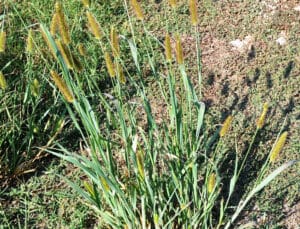Muhlenbergia schreberi J.F. Gmel.
Description
This native species thrives in both shaded and sunny areas and tolerates wet and droughty soils. Nimblewill typically invades thin turf in summer, forming grayish-green patches consisting of coarse-textured leaves and wiry stems. Patches become light brown or tan as nimblewill plants undergo dormancy during late fall and winter. Dormant plants are slow to green up in spring, and homeowners and professional turf managers find the light brown leaves and stems of nimblewill objectionable when contrasted against uniform green turf. Nimblewill can be controlled or suppressed with certain selective postemergence grass herbicides and good cultural practices.
Life Cycle
Nimblewill is a member of the Poaceae family and has a perennial life cycle. Plants undergo dormancy in late autumn with leaves falling from stems, and stems remaining upright and visible, taking on a bleached-straw color over the winter and into early spring. New stems and leaves emerge from crown tissues in spring and seed produced during the previous year begins to germinate in late spring or early summer. Following seed germination and the emergence of new leaves and stems, plants make rapid vegetative growth during summer. Nimblewill produces stolons, which creep along the soil surface forming patches in thin turf. Seedheads are produced from midsummer to October.
Identification
Nimblewill resembles some other perennial weed grasses that infest lawns, including creeping bentgrass, bermudagrass, and Japanese stiltgrass. Nimblewill can be distinguished from these other grasses by examining features of the leaf blade, ligules, stems, stolons, nodes, and seedheads. Leaf-blades of nimblewill are usually blue-green or grayish-green, more-or-less horizontally oriented, short (0.75 to 2 inches in length), and pointed at the tip. Leaf-blades of nimblewill look similar to those of Japanese stiltgrass; however, Japanese stiltgrass leaves are usually wider and often have a silver stripe down the center of the leaf (nimblewill leaf blades do not have any distinguishing markings). The ligule of nimblewill, located at the junction of the leaf sheath and leaf blade, is very short and membranous.
By contrast, bermudagrass ligules consist of a fringe of hairs and creeping bentgrass ligules are membranous but longer than those of nimblewill. Stems of nimblewill tend to grow in an upright fashion and are thin and wiry, whereas creeping bentgrass stems are slightly thicker and more flexible (not as stiff). Nimblewill stolons are generated from crowns of mature plants and give rise to new plants as they spread laterally away from the mother plant. Prominent nodes can be found on upright stems and on lateral stolons. Root systems are relatively shallow and can be easily pulled from the soil. Inconspicuous erect seedheads produce seeds on slender spikes. Seeds are small (about 2 to 3 millimeters in length without awns and 5 to 7 mm including awns), tear-drop shaped, and with long awns at tips.
Cultural Control
Nimblewill can be introduced into turf stands through the transfer of seed, stolons, and/or crown tissues on maintenance equipment, footwear, or soil used for renovation projects. Using soils from sites with no previous history of a nimblewill infestation can lessen the chances of contamination of turfgrass sites. If only a few nimblewill plants are infesting a lawn, they can be removed by hand pulling after stem and leaf emergence and before seedheads form later in the growing season. Improving turf density through fertilization and use of turfgrasses well-adapted to site conditions will help slow the spread of nimblewill but may not provide effective suppression once this weed is well established.
Chemical control
Chemical options for removing nimblewill from lawns include the use of the non-selective herbicide, glyphosate (Roundup), and selective herbicides containing mesotrione (Tenacity) and topramezone (Pylex). Glyphosate is generally used for spot treatments when only a few nimblewill plants are present in lawns. Glyphosate also kills desirable turfgrasses, so caution should be used when making spot treatments. Glyphosate spot treatments are most effective when nimblewill is actively growing in summer. In most cases, more than one application of glyphosate is needed for complete control as new shoots often emerge from nodes on surviving stolons.
Tenacity and Pylex are selective systemic herbicides that control nimblewill without killing desirable turfgrasses. These products are frequently used when many plants and large patches exist in lawns. Tenacity and Pylex control nimblewill by inhibiting chlorophyll and carotenoid pigments in foliage, causing plants to become white. Treated foliage dies back slowly, usually over a period of 2 to 3 weeks. One application of either of these herbicides rarely provides complete control of nimblewill and new foliage is often produced within several weeks or months of application. Tenacity and Pylex are most effective against nimblewill when applied two to three times over the course of the growing season when plants are actively growing. Be sure to follow label precautionary statements, restrictions, and directions regarding rates, the addition of surfactants, and the timing of applications when using these herbicides.





